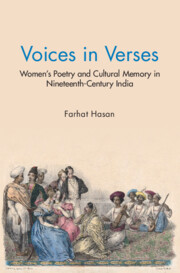Book contents
- Frontmatter
- Dedication
- Contents
- Acknowledgements
- A Note on Transliteration
- List of Abbreviations
- 1 Introduction
- 2 Unravelling the Texts: Memory, Reforms, and Literary Sulh-i-Kul
- 3 Representing an Inclusive Literary Culture: Women Poets in the Bazaars and Kothas
- 4 Representing the Kothas: The Two Sisters in the Literary Sphere
- 5 Commemorating Women Poets: Memory, Gender, and the Literary Culture in the Persianate World
- 6 Secluded Poets in Literary Spaces: Memorializing Female Rulers, Consorts, and Memsahibs
- 7 Conclusion
- Glossary
- Bibliography
- Index
6 - Secluded Poets in Literary Spaces: Memorializing Female Rulers, Consorts, and Memsahibs
Published online by Cambridge University Press: 06 March 2024
- Frontmatter
- Dedication
- Contents
- Acknowledgements
- A Note on Transliteration
- List of Abbreviations
- 1 Introduction
- 2 Unravelling the Texts: Memory, Reforms, and Literary Sulh-i-Kul
- 3 Representing an Inclusive Literary Culture: Women Poets in the Bazaars and Kothas
- 4 Representing the Kothas: The Two Sisters in the Literary Sphere
- 5 Commemorating Women Poets: Memory, Gender, and the Literary Culture in the Persianate World
- 6 Secluded Poets in Literary Spaces: Memorializing Female Rulers, Consorts, and Memsahibs
- 7 Conclusion
- Glossary
- Bibliography
- Index
Summary
In their biographical compendia, as mentioned earlier, Ranj and Nadir divide women poets into two broad categories: ‘public women’ and ‘secluded women’. Seclusion was an important marker of difference but, within the literary space, they were both represented as contributing to the enrichment and diversification of art, aesthetics, and language. The bāzārī ‘aurat, or ‘the woman of the market’, was defined by the absence of a household, and, of course, the word bāzār reflected her association with money – as someone who evoked the sensoria in exchange for an economic transaction. Definitions are elusive and reductionist; our tazkiras reveal these women as invested with a wide range of skills and linguistic abilities, leading an enriching life, and actively participating in the shaping of the social and cultural landscape. There was, as we have seen, a wide range of women who fell under this category, and there were considerable differences among them in terms of resources and patronage, caste and sub-caste affiliations, social location, profession, and place and type of performance. Furthermore, the boundaries that separated them from ‘chaste women’ were quite porous, and crossovers were not unknown.
Hindustani Poetry and Music in British Homes: English-speaking Women Composing Poems in Urdu
Described as pardah nashīn, or ‘women who live in seclusion’, these ‘chaste women’ were also marked by considerable diversity. There were some among them who belonged to the royal harem, but the harem was itself a diverse space; there were poets therein who had matrimonial relations with the rulers, and those who were their blood relations, and yet some others who served as concubines and slaves, but were still literate enough to compose poems. Our tazkiras refer to women poets who came from the homes of nobles, aristocrats, and, more interestingly, merchant houses as well. We also come across women poets who came from the home of an English official; the daughter of an English gentleman, Jami‘at was a ‘Hindustani’ from her maternal side. Described by both Ranj and Nadir as a ‘Christian woman’ (‘īsayī ‘aurat), she was married to a high-ranking British army officer, Major R. Justin. ‘Her lyrics were’, says Nadir, ‘on the lips of professional singers (gawa’iyōn) in the city of Agra’. She was also quite adept in the ‘knowledge of music’ (‘ilm-i musaqī). She knew English well and composed poems in Braj, Persian, and Urdu.
- Type
- Chapter
- Information
- Voices in VersesWomen's Poetry and Cultural Memory in Nineteenth-Century India, pp. 154 - 167Publisher: Cambridge University PressPrint publication year: 2024

